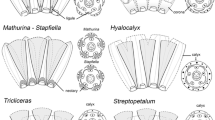Abstract
Paepalanthus subgen. Psilandra comprises two species known only from the type collections. The aim of this study is to evaluate their unique floral morphology within a given phylogenetic context and its implications for taxonomy. Flowers of both species were analyzed, described, and photographed using a digital microscope. Taxonomically relevant characters were mapped on previous molecular phylogenies. The flowers of both species fit the Paepalanthoideae pattern and are quite similar to each other. The petals of the pistillate flowers, although free, show evidence of previous fusion in the middle. The free condition is interpreted to be secondary, probably because of the handling of the specimens or to the current developmental stage. Character mapping indicates that both species share floral features with Syngonanthus but not with Paepalanthus. Therefore, based on the median fusion of the pistillate flower petals, absence of floral bracts, petals of the pistillate flower being shorter than the sepals, simple stigmas in the commissural position, the pedicellate pistillate flower, and the glabrous petals and sepals, we transfer P. subgen. Psilandra to synonymy of Syngonanthus sect. Syngonanthus and combine both species in this genus.



Similar content being viewed by others
References
Andrade MJG, Giulietti AM, Rapini A, Queiroz LP, Conceição AS, Almeida PRM, van den Berg C (2010) A comprehensive molecular phylogenetic analysis of Eriocaulaceae: evidence from nuclear (ITS) and plastid (psbA-trnH and trnL-trnF) DNA sequences. Taxon 59:379–388
Ayensu ES (1967) Aerosol OT solution—an effective softener of herbarium specimens for anatomical study. Biotech Histochem 42:155–156
Costa FN, Trovó M, Sano PT (2008) Eriocaulaceae na Cadeia do Espinhaço: riqueza, endemismo e ameaças. Megadiversidade 4:117–125
Cunningham JL (1969) Rapid alkaline rehydration of dried plant tissues for histologic study. Mycology investigations, Crops Research Division, Agricultural Research Service, US Department of Agriculture. Stain Technol 44:243–246
Giulietti AM, Hensold N (1990) Padrões de distribuição geográfica dos gêneros de Eriocaulaceae. Acta Botanica Brasilica 4:133–158
Giulietti AM, Harley RM, Queiroz LP, Wanderley MGL, van den Berg C (2005) Biodiversidade e conservação das plantas no Brasil. Megadiversidade 1:52–61
Giulietti AM, Andrade MJG, Parra LR, van den Berg C, Harley RM (2009) Proposal to conserve the name Syngonanthus against Philodice (Eriocaulaceae). Taxon 58:1008–1009
Hensold N (1988) Morphology and systematics of Paepalanthus subgenus Xeractis (Eriocaulaceae). Systematic Botany Monographs 23. The American Society of Plant Taxonomists, Michigan
Hensold N (1991) Revisionary studies in the Eriocaulaceae of Venezuela. Ann Mo Bot Gard 78:424–440
Hensold N (1999) Eriocaulaceae. In: Steyermark JA, Berry PE, Yatskievych K, Holst BR (eds) Flora of Venezuelan Guyana, 5th edn. MBG Press, Saint Louis, pp 1–58
Hensold N, Giulietti AM (1991) Revision and redefinition of the genus Rondonanthus Herzog (Eriocaulaceae). Ann Mo Bot Gard 78:441–459
Hensold N, Oliveira ALR, Giulietti AM (2012) Syngonanthus restingensis (Eriocaulaceae): a remarkable new species endemic to Brazilian coastal shrublands. Phytotaxa 40:1–11
Koernicke F (1863) Eriocaulaceae. In: Martius CFP, Eichler AW (eds) Flora brasiliensis 3rd. Typographia Regia, Monachii, pp 273–508
Maddison WP, Maddison DR (2009) Mesquite: a modular system for evolutionary analysis, version 2.74 for Macintosh. http://mesquiteproject.org
Martius CFP (1834) Die Eriocauleae als selbstständige Pflanzen-Familie aufgestellt und erläutert. Anales des Sciences Naturelles, Botanique 2(2):25–43
Moldenke HN (1963) Notas sobre Eriocaulaceae de Venezuela. Boletin de la Sociedad Venezolana de Ciencias Naturales 23:300–301
Moldenke HN (1975) Notes on new and noteworthy plants XCV. Phytologia 35:109–111
Parra LR, Giulietti AM, Andrade MJG, van den Berg C (2010) Reestablishment of Comanthera L.B. Sm. (Eriocaulaceae): for the clade Syngonanthus sect. Eulepis and S. sect. Thysanocephalus as inferred by molecular and morphological data. Taxon 59:1135–1146
Peterson RL, Hersey RE, Brisson JD (1978) Embedding softened herbarium material in Spurr’s resin for histological studies. Stain Technol 53:1–9
Radford AE, Dickison WC, Massey JR, Bell CR (1974) Vascular plant systematics. Harper and Row Pub, New York
Rosa MM, Scatena VL (2007) Floral anatomy of Paepalanthoideae (Eriocaulaceae, Poales), and their nectariferous structures. Ann Bot 99:131–139
Ruhland W (1903) Eriocaulaceae. In: Engler A (ed) Das Pflanzenreich, Regni vegetabilis conspectus IV. 30 (Heft 13). W. Engelmann, Leipzig, pp 1–94
Silveira AA (1908) Flora e serras Mineiras. Imprensa Official, Belo Horizonte
Silveira AA (1928) Floralia Montium. Imprensa Official, Belo Horizonte
Stützel T (1984) Blüten und Infloreszenzmorphologische Untersuchungen zur Systematik der Eriocaulaceen. Dissertationes Botanicae 71. J. Cramer, Berlin
Stützel T (1987) On the morphological and systematic position of the genus Moldenkeanthus (Eriocaulaceae). Plant Syst Evol 156:133–141
Stützel T (1998) Eriocaulaceae. In: Kubitzki K (ed) The families and genera of vascular plants IV: flowering plants: monocotyledons: Alismatanae and Comelinanae (except Gramineae). Springer, Berlin, pp 197–207
Trovó M (2010) Sistemática de Paepalanthoideae (Eriocaulaceae): filogenia, morfologia e taxonomia de Diphyomene (Ruhland) Trovó. Ph.D. thesis, Universidade de São Paulo, São Paulo
Trovó M, Andrade MJG, Sano PT, Ribeiro PL van den Berg C (2012) Molecular Phylogeny and Biogeography of Neotropical Paepalanthoideae Ruhland with emphasis on Brazilian Paepalanthus Mart. (Eriocaulaceae). Bot J Linn Soc (in press)
Unwin MM (2004). Molecular systematics of Eriocaulaceae Martynov. Ph.D. thesis, Miami University, Oxford
Weberling F (1989) Morphology of flowers and inflorescences. Cambridge University Press, Cambridge
Acknowledgments
Authors would like to thank the curators of the following herbaria: ALCB, B, BHCB, BOCH, BR, C, CEN, CEPEC, CVRD, ESA, F, G, GFJP, HBG, HEPH, HRCB, HUEFS, IBGE, INPA, K, LE, L, LL, M, MBM, NY, OUPR, P, R, RB, S, SP, SPF, UB, UEC, UPS, US, W, and WU for access to the specimens used in this manuscript. We are especially in debt to Dr. Robert Vogt, who permitted the analysis of the type specimens under the digital microscope. We also thank Livia Echternacht and Dr. Nancy Hensold for helpful discussions and information. Financial support was provided to M.T. from the Alexander von Humboldt Foundation. Jim Hesson and AcademicEnglishSolutions.com revised the English.
Author information
Authors and Affiliations
Corresponding author
Rights and permissions
About this article
Cite this article
Trovó, M., Stützel, T. On the morphological position of Paepalanthus subgenus Psilandra (Eriocaulaceae). Plant Syst Evol 299, 115–121 (2013). https://doi.org/10.1007/s00606-012-0708-3
Received:
Accepted:
Published:
Issue Date:
DOI: https://doi.org/10.1007/s00606-012-0708-3




